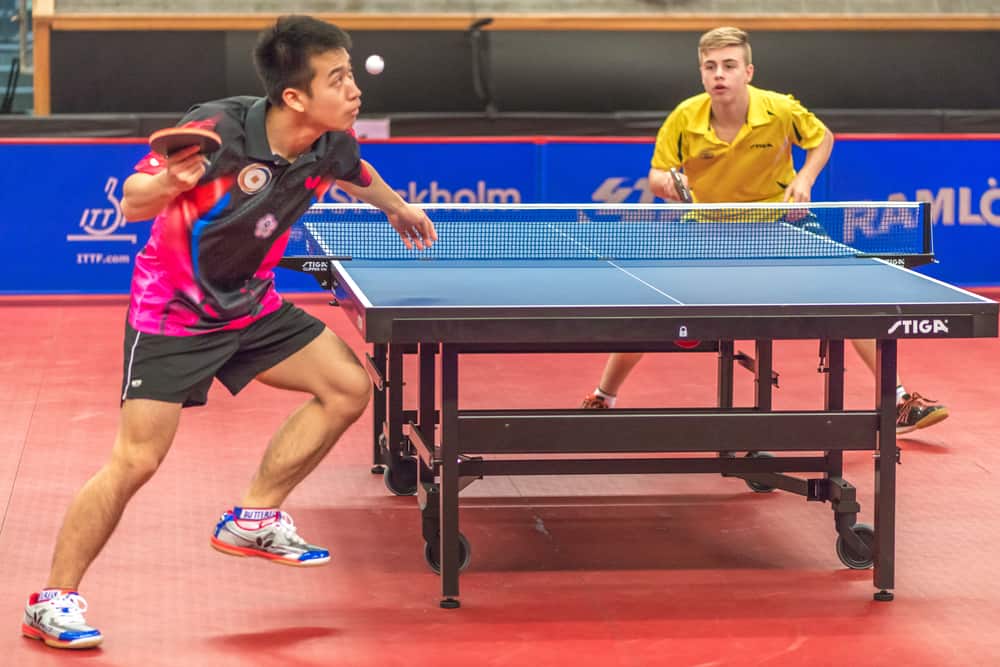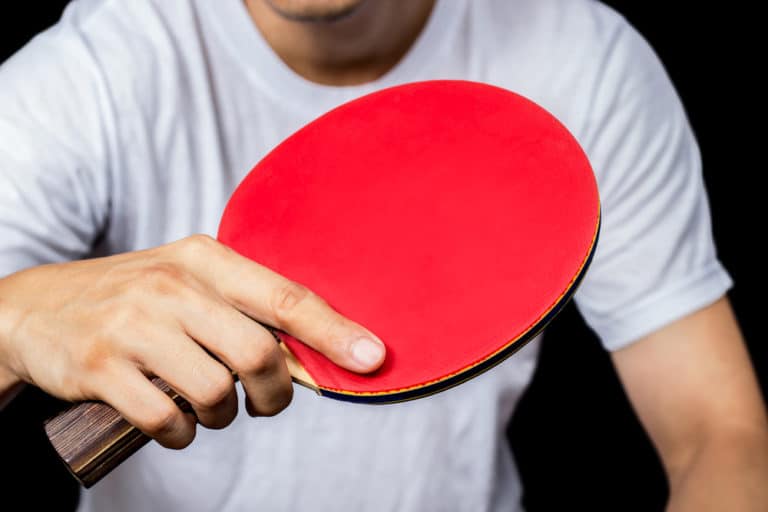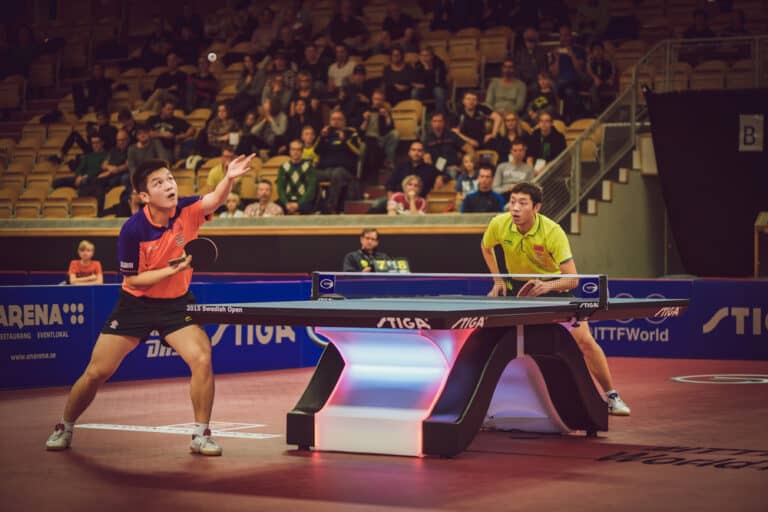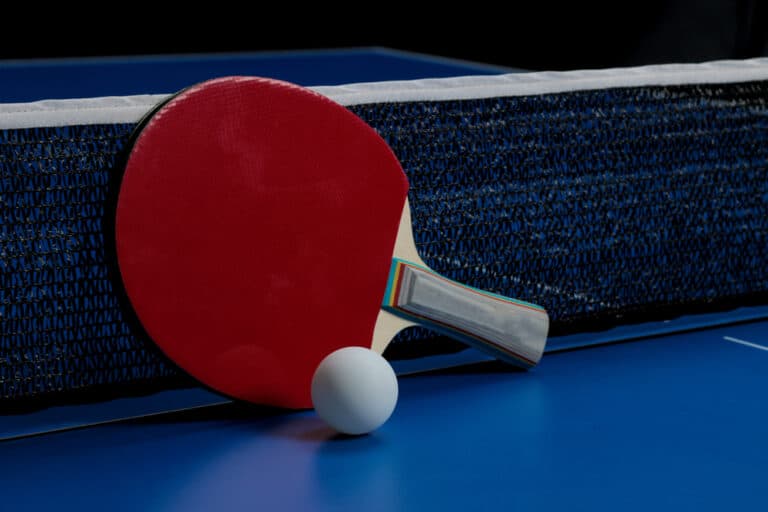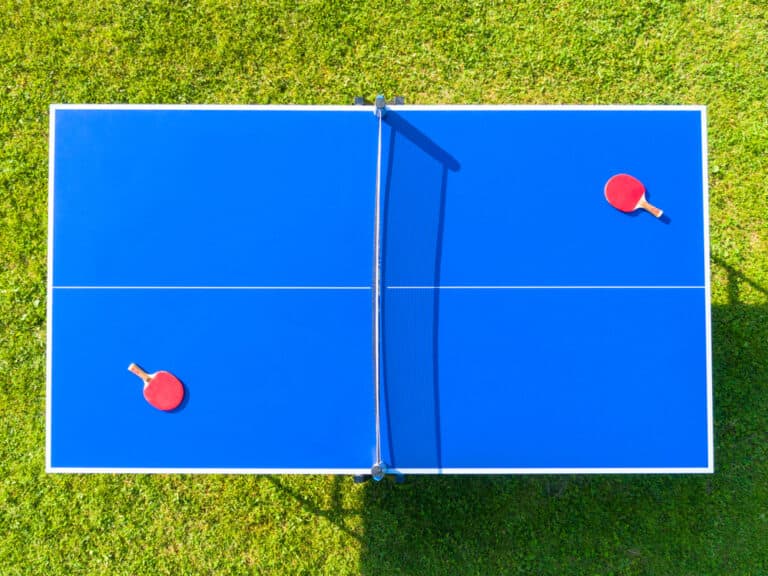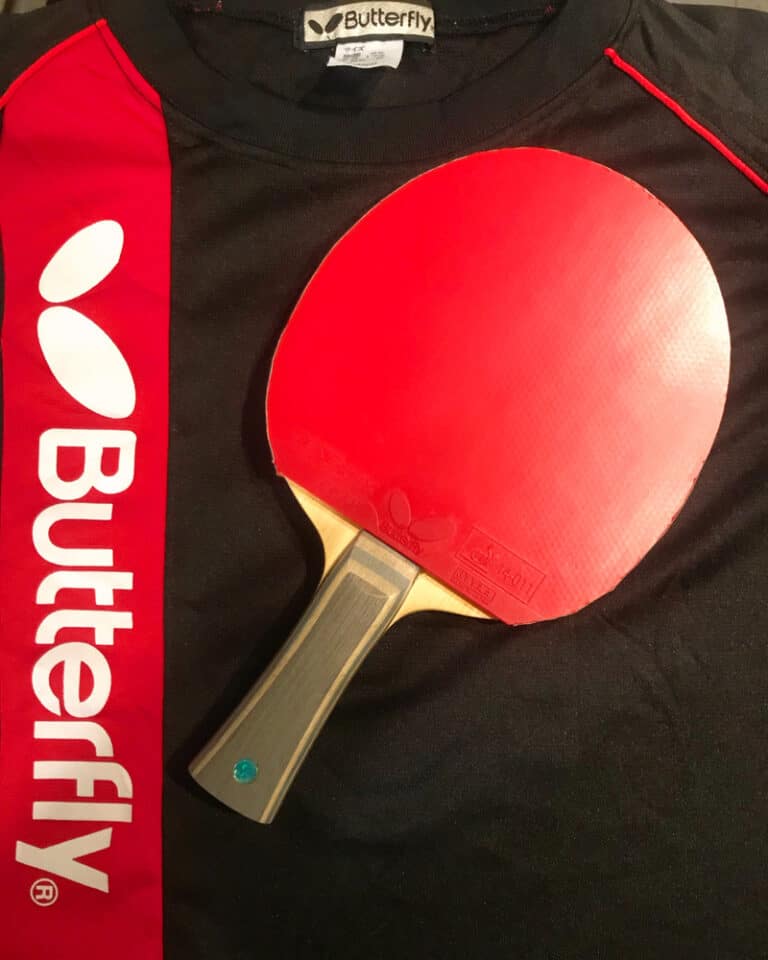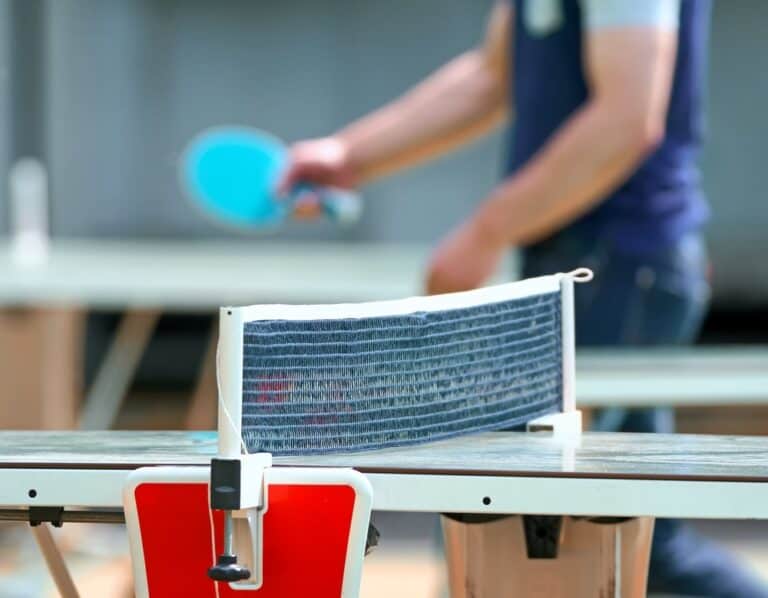Why Do Table Tennis Players Stomp – Everything You Need To Know
If you’re new to table tennis or enjoy watching professionals play, you may have noticed their habit of stomping when they serve. While I myself don’t have a habit of stomping, I have many friends and rivals who stomp, and their reasons vary dramatically, although they are nonetheless pretty interesting! So, why do t able tennis players stomp?
Table tennis players stomp because it gives them an advantage during a service. The stomping sound masks the contact between the ball and bat, making it harder for the receiver to predict the spin on the ball and the type of serve. It helps distribute weight & balance and distracts the opponent.
While stomping is an acceptable practice, it remains somewhat controversial among players. Some tournaments do not allow it and penalize players who use it. We’ll cover varying reasons why players might stomp and how the practice measures up on a professional level with referees. Lastly, we’ll delve into the ethical consequences of stomping from the perspective of the players.
Why Do Table Tennis Players Stomp?
When it comes to watching experienced table tennis players, it’s not always clear why they do certain things. For instance, many experienced players choose to stomp their feet when they serve. While it may appear meaningless, there are multiple reasons why they might stomp, with the primary reason being to gain an advantage over their opponent.
More specifically, stomping gives players a tactical advantage. It allows the serving player to hide the sound of the service at the moment of contact, making it harder for the receiver to calculate the speed and the amount of spin of the oncoming ball.
It is vital when a player wants to serve a backspin while employing a bit of deception to make it look like a topspin and vice-versa. The sound from the stomp is a two-fold psychological tool for distracting the receiver by diminishing their capacity to use their senses and awareness and to hide the server’s choice of weaponry.
The sound a table tennis paddle makes from the player hitting the ball with their bat can be very telling. It is often enough for an experienced player to identify the kind of bat the opponent uses, i.e., the materials and the potential for specific shots.
Consequently, it will give the player insight into their opponent’s playstyle. For this reason, stomping hides a player’s choice of weaponry.
By hiding the sound of a serve with a stomp, players can mask the type of serve they want to deliver – whether hard, soft, curved, or with spin. Other players might stomp as part of a natural motion when they apply spin to their serve.
Perhaps more important than masking the sound and nature of a serve, stomping also helps to make the contact touch point of the bat and the ball indistinguishable.
Consequently, it makes it more difficult for the opponent to know when the server’s bat made contact with the ball – will it be when the bat moves up or down or at the point closest to the net?
Stomping Helps Players Get Into The Ready Position
Right-handed players should stomp with their left foot while rotating their bodies at the same time. As a result, players will more quickly enter the ready stance, giving them a slight advantage when they must react to a returning shot.
By the time the ball leaves their bat, they will be in a comfortable position to observe their opponent carefully, giving them valuable time to plan their next move.
At the same time, some players utilize stomping as an intimidation tactic to throw the opponent off and make them less likely to read their movements. It also serves as a tool for players to assert their dominance and demoralize the opponent in such a way that they will lose confidence in their own abilities.
Stomping Gives Some Players A Weight Advantage
Some table tennis players utilize stomping as a technique for shifting their weight forward to increase the power of their serve. A similar practice exists in tennis when players will jump and hit their ball when serving or lean forward during ground strokes.
It has nothing to do with distracting the opponent (more on this later), nor is it ever an exaggerated way to lift their feet off the ground to create a noise. Instead, for some players, it’s a habit that is hard to break, like swinging a baseball bat with the left foot because they’re right-handed.
Further examples of practices that become habits are evident in NBA basketball and tennis. Almost every NBA player has a habit of bouncing the ball and spinning it a few times before taking their free throw, or tennis players bounce the ball before serving. It just gets all your body mechanics and mind in order.
Similarly, stomping is a tool to help them transfer the right amount of weight for the perfect serve.
Players do not always remain flat-footed during mid-rally; the same applies during a service. Stomping helps players step into it to help with timing and transferring body weight to generate as much spin as possible.
Table Tennis Players Might Stomp For Balance
Table tennis players don’t usually share the same winning strategies unless a clear, proven, and dominant alternative exists. As such, some players opt to use stomping as a psychological trigger for improving their balance. Additional benefits also include improved consistency and timing on shots.
A similar technique exists in tennis that states when a player goes to the net to contest a volley, they should stompwith their left foot if they are right-handed for a forehand volley and stomp with their right foot for a backhand volley.
This technique boosts your mental and physical faculties because you get to make the shot with a steady wrist and perfect balance.
What’s the History Behind Table Tennis Players Stomping?
Players implemented stomping during the infant days of table tennis when balls were unregulated and had different colored rubber. When a table tennis bat made contact with the ball, experienced players could tell the kind of shot by the sound, so players started stomping to eliminate the sound.
Stomping is actually not a recent development, having existed for a long time and dating back to when table tennis officials did not regulate the color of table tennis rubber.
You could have long pips on one side and inverted on the other, or both could be black, red, blue, or green. These factors introduced a problem where the opponent receiving the serve could hear the difference in contact between different types of rubber.
In order to improve their odds of victory, experienced table tennis players disguised the sound from the bat and the ball by stomping when they served.
The issue eventually faded away after the table tennis officials mandated the combination of red and black rubber. However, the act of stomping continues to flourish as a valued practice today.
It might even afford players a little intimidation, but the original purpose of stomping has long since joined the ranks of historical traditions.
Can Stomping Give Table Tennis Players More Spin?
Stomping does not allow players to apply more spin. Instead, spin comes from brushing the bat over the ball in a fast motion.
Some players might state that stomping increases their spin by transferring power from their legs to their arms. Contrary to belief, it’s not the act of stomping that gives more spin, but rather the fact that stomping bends your knees and makes it easier to brush the ball.
Spin will always derive from the fast brushing contact of the bat on the ball. Stomping helps get the foot into position for the ball and distracts the opponent.
However, while stomping may not improve spin, it can equip the player with a psychological advantage. Have you ever heard someone say, whether you think you can or can’t, you’re right.
Whether it’s true or not, players often gain confidence and improve their performance during a game with a positive mindset. The same principle also applies backward; someone who believes 40 is too old to go back to school won’t see it through, even though they have the opportunity.
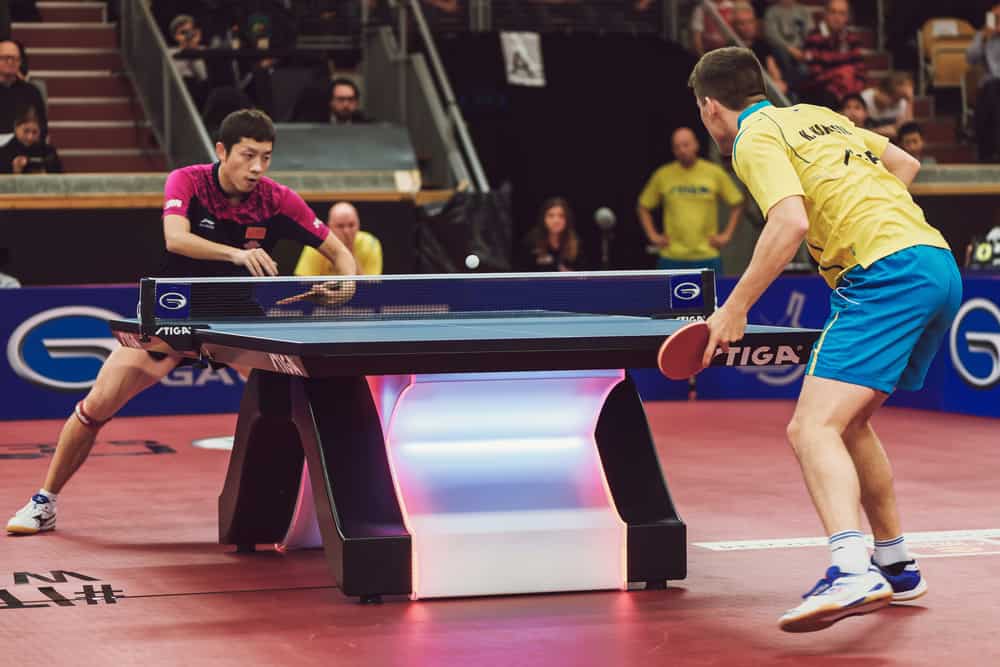
Why Can Stomping Be Controversial Among Players?
Stomping is controversial because it distracts the opposition, and referees consider it a serious misconduct to stomp for the explicit purpose of distracting another player.
Despite the benefits of stomping, it remains a sore topic for many players who dislike the practice, stating that it is unnecessary and unprofessional.
It becomes a problem when players do it because they purposefully want to distract the opposition. In this case, it would be similar to handicapping a player to reduce their chances of winning and therefore is not permissible.
The referee is responsible for deciding whether a player is using stomping for malicious purposes. In some cases, tournaments will strictly forbid the practice and fault players for the practice, no matter how sincerely they claim it forms part of their preparation process.
It can become especially heated when players stomp the moment their opponent is about to strike the ball. This kind of behavior is a gross misconduct in table tennis, and the referee or players will see it as an attempt to distract the other player.
From A Player’s Perspective, Why Is Stomping Distracting?
Stomping is a distraction because players tend to focus on their opponent and the ball and associate sound with specific actions.
The primary reason why stomping is a distraction for most players is that the sound never matches the expected outcome.
For instance, it is natural for most players to have their attention on their opponent and what they intend to do with the ball – reading their body language – if you will. When the opponent is on the cusp of making a play, the receiver intends to match the sound with their prediction to get the most accurate reading on their opponent.
At the end of a service, the receiver’s focus shifts to the ball, with a slight peripheral concentrate on the opponent. When the receiver experiences an entirely different result because a stomp skewed the sound, something they have no control over invalidates their experience and puts them at a disadvantage.
So, Is It Acceptable To Keep Stomping?
While controversial, stomping can be equally a part of service action as pre-strike paddle motion. Both are tools to assist the player in hiding the amount of spin a player applies to the ball.
Furthermore, stomping can also be an innocent side-effect of a server shifting their weight from left to right to give their stroke that extra bit of power.
That said, the receiver has no business stomping their foot before the ball even leaves the server’s side of the court. Such an action is a clear sign of wanting to distract their opponent. In fact, it’s the same reason why it’s not permissible to wave your hands, scream MISS!, or burst into song at any point during the game.
Thus, reasonable stomping is acceptable, even though it bears some negative stigmas.
Furthermore, remember that It’s pretty obvious when a player intentionally tries to break the other player’s focus. If it weren’t apparent, the other play wouldn’t notice, and your efforts would amount to plenty of excessive and wasted motion from the player stomping.
In fact, you may even decide to participate in a sanctioned tournament and play in a match with a referee. Test the limits of how obnoxiously you can stomp before you receive a warning.
Conclusion
Table tennis players primarily stomp because they gain a tactical advantage during a service, typically in the form of sound and distracting the opposition. Some players do it out of habit or because it helps them distribute their weight, while stomping help other players generate more power for the shots. It’s not an illegal practice, although it remains controversial among players.
Sources
- https://www.quora.com/Why-do-table-tennis-players-stomp-when-they-serve-the-ball
- https://www.quora.com/Why-does-table-tennis-players-hit-the-ground-with-their-legs-while-releasing-the-serve-ball
- https://www.youtube.com/watch?v=NJZ7phWtKs0
- https://www.youtube.com/watch?v=–CEqSDd5yQ
- http://mytabletennis.net/forum/foot-stomping-on-serve-not-illegal_topic41840_page2.html
- https://www.youtube.com/watch?v=uIMEQzgJL0E

